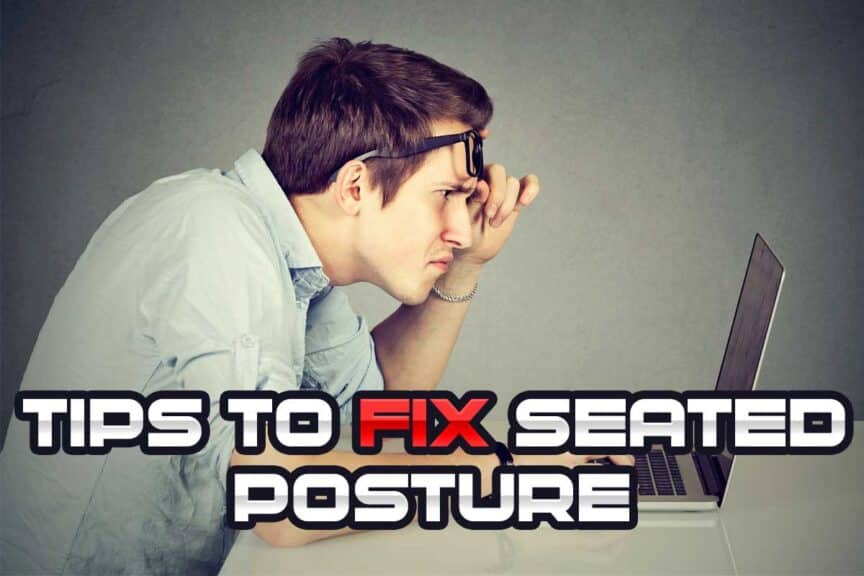They say that sitting is the new smoking. That’s the catch-phrase that has risen to prominence in the modern age of ever-increasing time spent sitting down at desks and workstations. Indeed, high amounts of prolonged sitting can wreak havoc on our posture and tends to give us all sorts of aches and pains as a result.
But the good news is that even if you have to sit a lot a part of your daily work or life requirements, there’s plenty of great ways you can help fix your posture and avoid the aches and pains that would otherwise come along for the ride.
The best steps to take when beginning to fix your sitting posture begin by taking note of how your body feels when sitting and then making specific adjustments to your sitting position in ways that reduce unnecessary stress and strain. It’s also important to incorporate bodily movements at routine intervals so that you avoid being in one motionless position for too long.
If you want the detailed breakdown and specific information for these aforementioned steps, be sure to keep reading the article! As well, I’m including a bonus tip at the end of this article that can help ensure that you avoid a common cause of low back pain that many people incur from frequent and prolonged sitting.

Article contents (Quick links)
Click/tap on any of the following article contents if you’d like to jump right to that particular section!
- Remember: Posture is somewhat subjective
- What about posture correction devices?
- Take note of how your body is feeling as you sit down
- Tip 1: Raise arm rests
- Tip 2: Sit as far back in your chair as possible
- Tip 3: Use a lumbar support for your low back
- Tip 4: Set your computer monitor up to the right height
- Tip 5: Use movement snacks to break up your sitting posture
- Bonus tip: Squeeze your bum from time to time to avoid low back pain
- Concluding remarks
Related articles:
- The MASSIVE Benefits of Going to Physical Therapy Before Injury
- Blood Flow Restriction: Evidence and Uses for Injury Rehabilitation
- What is Blood Flow Restriction Training? How, Why and When to Use it
Remember: Posture is somewhat subjective
As we dive into the strategies within this article, keep in mind that “posture” is somewhat of a subjective thing; no two human beings are put together exactly the same and what might be less posturally than ideal for one person might in fact be just fine for another.
Therefore, the main thing to focus on is what feels best for you! If a tip within this article feels good for you, take it and run with it! Conversely, if something doesn’t feel good for you, don’t feel like you must implement it – we’re all a bit different and have slightly different needs. These tips are just general starting points to implement as you work to finding postures and positions that work best for you.
What about posture correction devices?
If you’ve been interested in correcting your sitting posture for more than a short length of time, you’ve likely come across various posture correction devices that aim to help your sit upright, keep your shoulders pulled back, etc.
While it’s admirable that so many companies want to help correct your posture, I’m not personally the world’s biggest fan of certain types of these devices. But there are some that I think are worth the money.
Shoulder straps (passive intervention)
The most prominent postural correctors on the market tend to be straps that actively work to pull your shoulders back for you. While I find some value in these, I find that they tend to pull the shoulders too far backwards on most people; the shoulders tend to be best left in a more neutral position – not letting them round forward but not forcing them to be pulled back all the way either.
As well, it’s oftentimes not overly comfortable for people have these devices on for prolonged periods of time, as they sometimes find the straps to become uncomfortable as they dig into the front of their shoulders.
I’m also not a fan of passively relying on these straps by letting them do all the work for you. Again, these devices certainly have merit and can be quite ideal for certain individuals based on their needs, but there are other upper body postural devices that I prefer instead.
Nonetheless, if you would like to try one of these devices, the good news is that they’re rather inexpensive. You could spring for this particular posture corrector (link takes you to Amazon), which seems to have an incredibly high number of positive reviews. Note: this is an affiliate link, which means I receive a small commission at no extra cost to you when you purchase through it. The commissions I earn help to offset the cost of running this website, which is a passion project of mine.
Biofeedback devices (active intervention)
What may be a better option for most people is using an active feedback device that simply reminds you when you need to do the work to correct yourself. Aside from not relying on a device to always do the work for you, you’ll be able to simply correct your upper body positioning without pulling your shoulders too far back.
By you doing the work to change your posture, your activating your own muscles, which can be quite a pain relieving phenomenon in and of itself. You also won’t have to worry about uncomfortable straps always digging into your skin throughout the day.
So if you’re really considering investing some money into a postural device, something along the lines of this Upright GO Posture Trainer (link takes you to Amazon) may be your best bet. This is the type of device I would personally spring for if I wanted to work on my upper body posture with the help of an external device.
Take note of how your body is feeling as you sit down
When it comes to making an attempt to improve your sitting posture, the first step to take is to assess how you’re feeling when you sit down; raising your own awareness to how your body is feeling is critical if you want to make effective postural changes that leave you feeling better and moving better.
Once you have a better idea of how your body is feeling, you’ll want to keep that in mind as you read through the following tips. You may just have a better idea of which tips can help you the most and which ones you don’t need to worry about as much.
Tip 1: Make sure that your armrests are at a proper height
Reason: Low arm rests can put unnecessary strain on your upper shoulder muscles and your neck while also forcing them both into less ideal positions.

If your chair has armrests (and if they’re adjustable) you’ll want to make sure that they’re set up to the proper height. Yes, there is such a thing as proper armrest height.
One of the most common things I deal with in the clinic when it comes to patients who have to routinely sit for long periods throughout the day is abnormal amounts of stress on the neck and shoulders while they’re sitting.
The fact of the matter is that gravity is always working against us when we sit, and if our arms are unsupported, we may get some uncomfortable stress and tension in our upper shoulders and neck as the result of gravity pulling them down. When the shoulders are being pulled down, the tissues connecting from the neck to the shoulders (muscles and nerves, in particular) get stretched out for prolonged periods of time and on a regular basis, which can in fact make them quite sore and/or tense.
The solution to this is of course to not let gravity always be pulling your arms and shoulders downwards. But actively keeping your shoulders shrugged all day long to offset this downward tension is quite impractical along with being a sure-fire way to develop excessive tension and soreness in your upper shoulders and neck. So the solution is to have your armrests set up to a height that allows you to keep your shoulders and arms relaxed without gravity constantly pulling them downwards.
The proper height means that your arms and shoulders can rest in a more neutral position (not being pulled down too far) while also actually resting, so that your shoulder muscles don’t stay actively shrugged upwards all day long.
Tip 2: Sit as far back in your chair as possible to keep your low back happy
Reason: Sitting far back in your chair can help prevent your lower back from rounding too much and becoming painful.
Many people are aware that they slump with their posture when sitting down. What many people don’t realize, however, is that slumping while sitting affects your low back just as much as your mid and upper back.
Sitting down with a rounder lower spine (the lumbar spine) puts excessive amounts of pressure on the discs, which are the little rubber hockey puck-like structures between each vertebra. If you can find a way to sit with a neutral lumbar spine rather than one that is rounded, you’ll undoubtedly save yourself a world of pain and trouble in the long run.
The easiest way to go about making this change is to sit as far back in your chair as possible. Most people who sit with a rounded lower spine tend to sit with their butt more towards the edge of the seat. This is prime territory for letting your entire back (especially the lower back) round into a slumped posture.
What happens when we sit far backwards in the chair
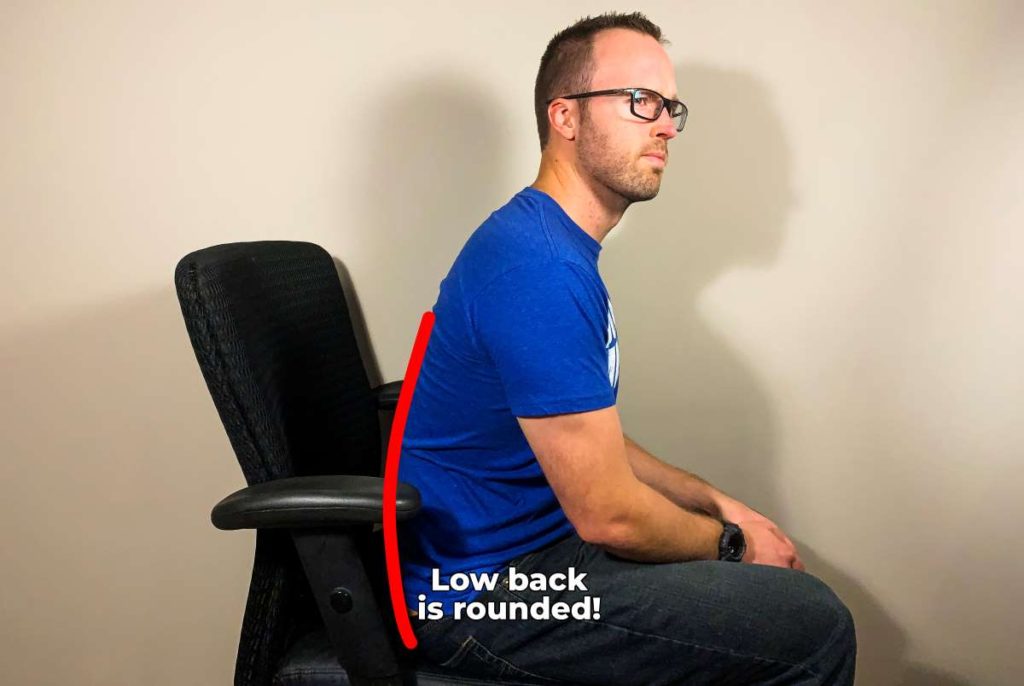
By sitting as far back as you can, your lower back will tend to say in a straighter position. This is due to the fact that if you try to let it round, it will be pressed into the back of the chair, which will prevent it from rounding any further. Additionally, the sensation of your back pressing into the back of the chair will remind you to try and sit up straight a little bit more. When the back of the chair supports your lumbar spine, we refer to it as…lumbar support.
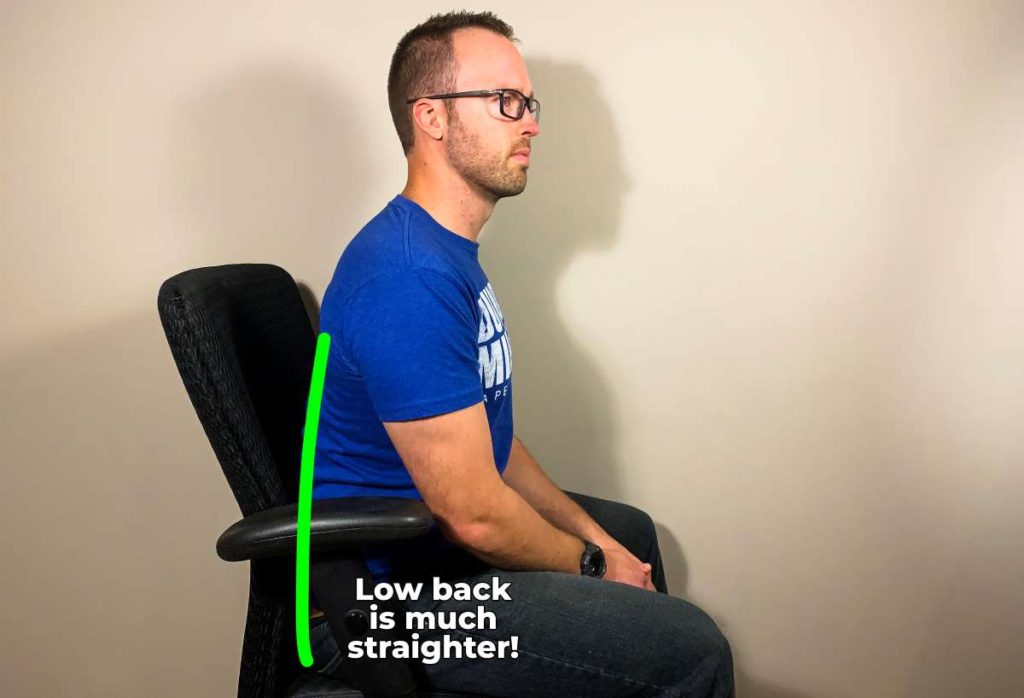
Unfortunately, not every chair is the same and many chairs don’t offer very good lumbar support. Even if you find yourself sitting as far back as possible you still may not feel like this is as helpful as it could be. If this is the case, don’t worry, as my next tip will have you covered.
Tip 3: Use a lumbar support for your low back
Reason: Sometimes chairs don’t offer enough lumbar support for our back by themselves.
Lumbar supports can be absolutely amazing for correcting your sitting posture. For me personally, they have made a world of difference after having spent a few years with some nasty back pain years ago in my younger days. They may feel a bit unnatural at first, but for many people (myself included), once you get used to them you can’t image not using them.
There are a million different types of lumbar support out there, all ranging in design and price. It can be a bit overwhelming to try and figure out which one will serve you best, but my recommendation is to start out with a pool noodle, (yes, you read that right).
Just watch my video below for more information. Pool noodles are dirt cheap and conform to your back perfectly just after a few sessions in your chair.
Tip 4: Set your computer monitor up at the right height to avoid neck strain
Reason: A computer monitor that is set too low can put unnecessary strain on your neck muscles and joints due to holding your head too far out in front.
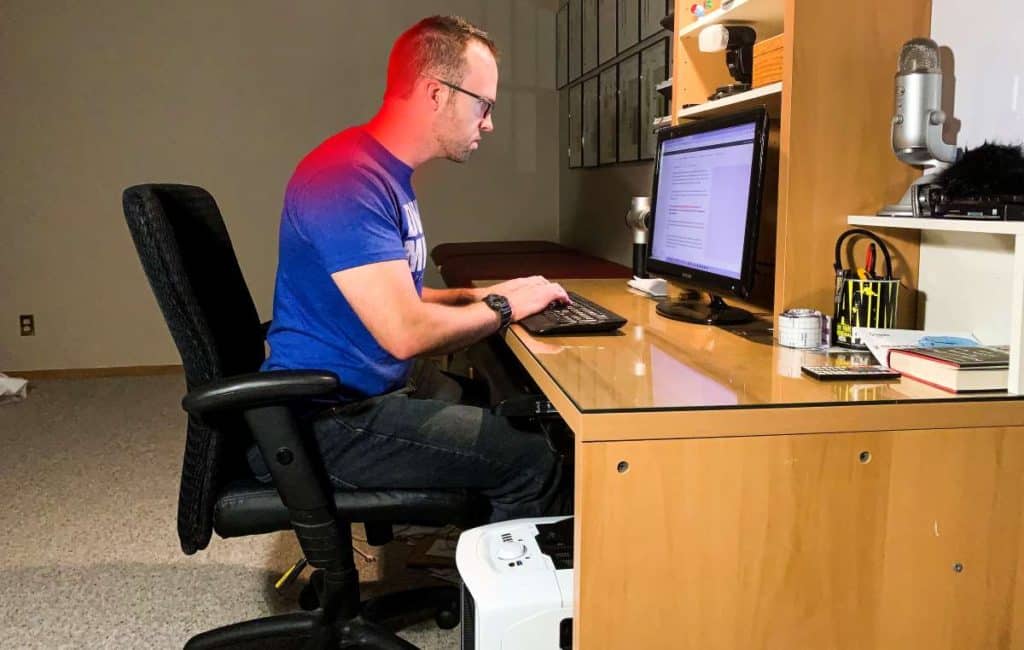
The vast majority of people who sit for long periods of time at a desk these days tend to have a computer screen in front of them. While computers have no doubt done many amazing things for our lives, they tend to wreak havoc on our necks. But the blame can’t be placed solely on a computer screen; the blame is more on us for not setting the screen up to an appropriate height for us to look at.
When a computer screen is sitting at the right height while we stare at it, it helps to not only keep our necks in a much more ideal position or posture, but it also helps to alleviate an extraordinary amount of mechanical strain on our necks as a result.
The vast majority of people tend to stare at a computer screen that is set up a bit too low for them. This results in the head sitting a bit too far forwards in relation to the rest of our body. This in turn puts tons of stress through the muscles and joints of the neck and upper back. No bueno.
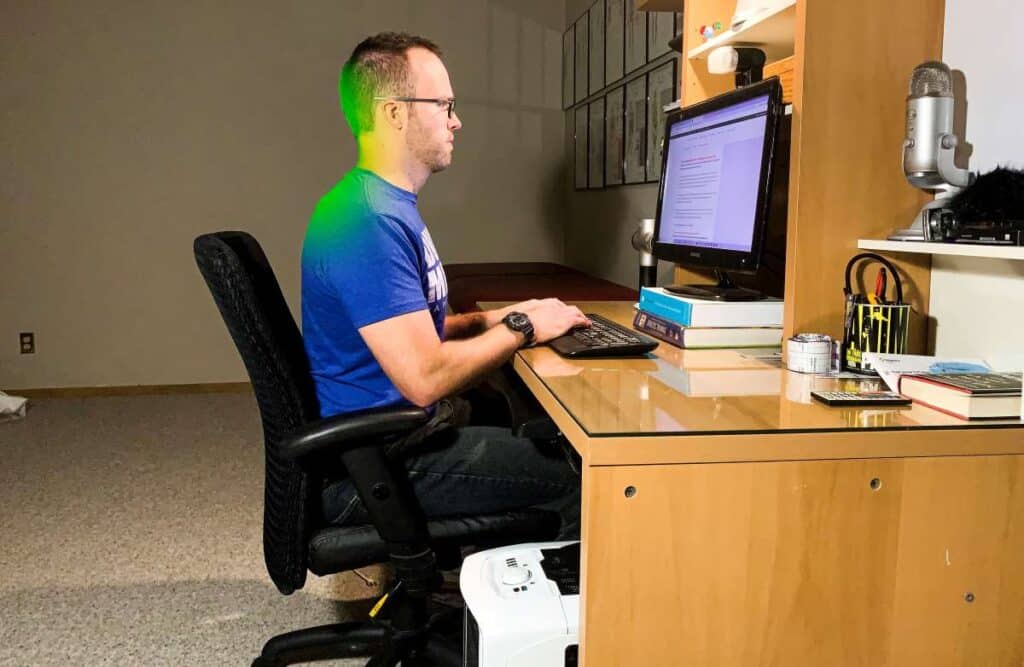
How to set your computer screen up to the proper height:
If you’re curious as to what the proper monitor height is in regards to achieving ideal sitting posture, the general rule to follow is that you want to set it at a height where you can comfortably stare at it when you tuck your chin or nose down about one inch from looking directly straight forward.
This position keeps your neck pretty neutral so that you upper neck joints don’t get sore or stiff from looking upwards too much while the base of your neck joints don’t get too sore from looking excessively downward too much.
Tip 5: Use movement snacks to break up your sitting posture
Reason: Sitting for long periods of time without physical movement is a guaranteed way to encounter aches and pains while also making it harder to achieve better sitting postures.
The longer (and more frequently) we keep ourselves in a static position, the more our body begins to adopt taking up those positions on a permanent basis. One of the best ways to not only avoid the trap of developing pain and discomfort from poor posture is to routinely break out of those positions and move around.
Think of little random breaks from sustained postural positions (i.e. sitting down at a desk) as a quick little reset to our muscles, joints and tissues within our body.
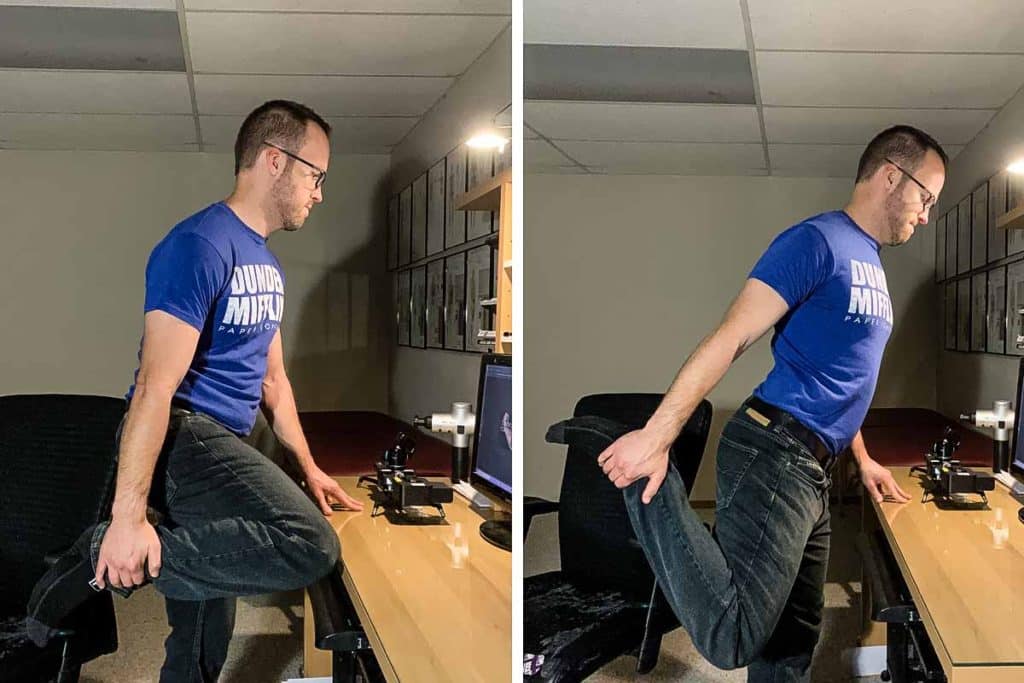
In the world of physical therapy and movement, we call this a movement snack. If doing a regular work out session at the gym is like eating a full meal at the table, then doing frequent, little one or two-minute movement breaks at your desk is like snacking throughout the day
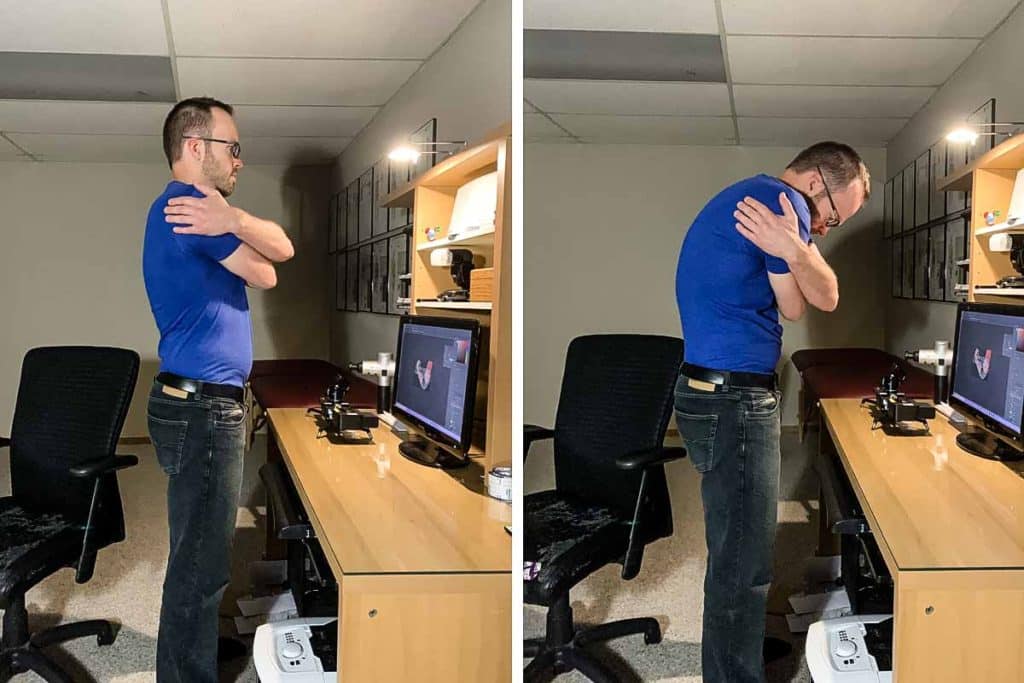
Movement snacking is all about performing any type of movement that just feels good for you to do – they can be stretches, gentle strengthening exercises, or anything else that feels good. They can be done for thirty seconds or five-minutes, whatever you feel is best for you.
Some of my favorite movement snacks that I do when needing to take a quick break from sitting down at a desk include movements like gentle backwards bends, shoulder blade hugs and squats. When I do my movement snacks, I never count reps or do anything of the sort, rather I just go by how my body is feeling and what it seems to want in that moment!
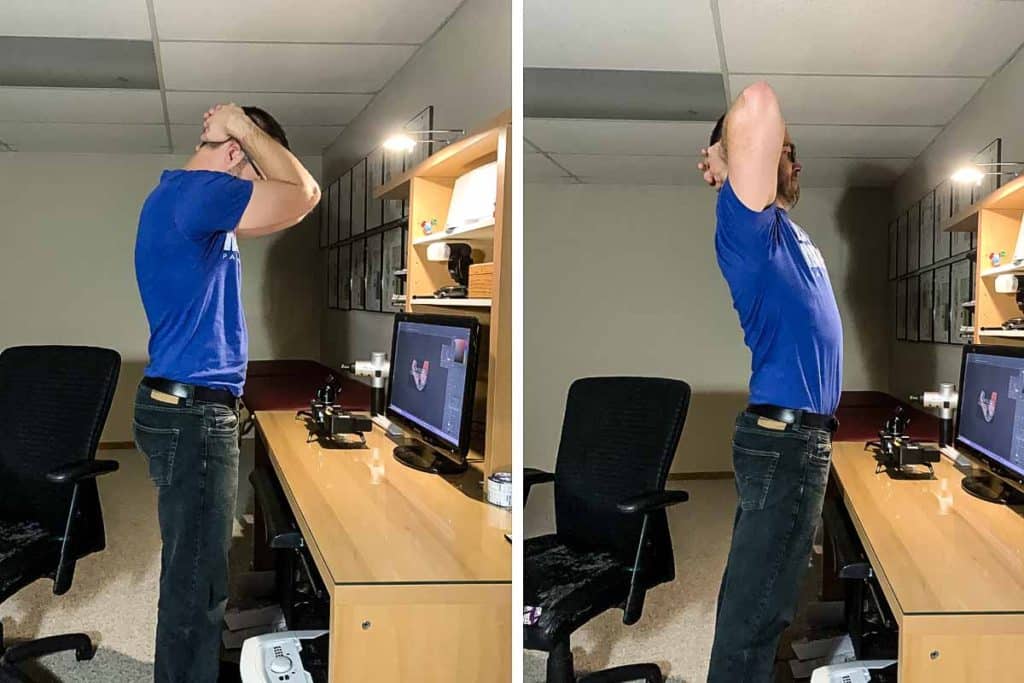
Try setting a timer for yourself and see how it feels to do one or two movement snacks every 30 minutes. You could try every 20 minutes or 45 minutes if you want – it all comes down to what feels best for you!
Implementing this strategy not only breaks you out of a sustained position or posture on a frequent basis, but they help to get blood flowing and joints moving, which will feel good and help you to stay mobile and out of pain.
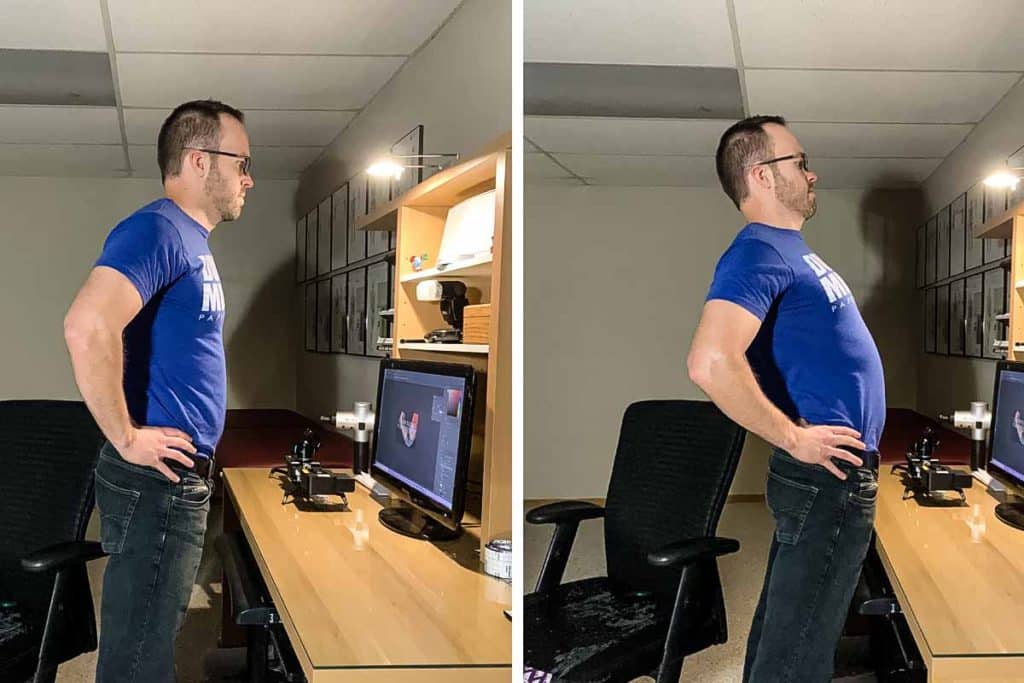
Bonus tip: Squeeze your bum from time to time to avoid low back pain
Reason: Keeping your glute muscles active can help prevent nasty and chronic lower back pain.
This may not sound like typical postural advice, but you’d be surprised at just how much pain you can stay out of by making sure your gluteal muscles get some frequent activation (by squeezing them) as you sit down throughout the day.
Sitting down forces the big gluteus maximus muscle to go into a stretched or lengthened out position. While you may think this is a good thing to stretch this muscle out, it’s not so much of a good thing if the muscle is chronically stretched out for multiple hours every day.
The result of this sustained position is a decrease in neurological activation to this muscle (holding a muscle in a static stretch will generally neurologically fatigue a muscle). What makes this such a lousy thing is that there’s a high correlation between having “sleepy” glutes and low back pain. Why? Because the hips and low back both need to be healthy and strong in order to avoid low back pain.
Without getting into detailed anatomy, the low back muscles and the gluteal muscles (glute max, glute med & glute min) play off of each other a lot when it comes to producing movement and maintaining stability all around the hips and lower back region (the lumbopelvic region of the body). Having a deficiency in one tends to affect the other. Think of it like a balancing scale; if one side of the scale is too light (i.e. the hips aren’t strong enough), the scale sinks on the other side (i.e. pain in the low back starts to occur).
There’s no hard and fast rule when it comes to keeping your glutes active, but many health professionals (myself included) subscribe to the belief that doing 20-30 squeezes after every hour that you’ve been sitting down for can in fact be a great way to make sure that your glutes don’t get “sleepy”.
If you want to make sure that you’re getting a good squeeze, try this: Sit up nice and tall and then squeeze your bum. You should feel your body rise upwards by an inch or so when you do this, as if your head is now one inch closer to the ceiling. Hold a good squeeze for one or two seconds and then relax. Repeat as needed.
Concluding remarks
There’s no single universal posture that is right for everyone, however there tend to be some good general guidelines to follow; sitting in sustained positions for a prolonged length of time (especially on a routine basis) isn’t an ideal situation and the first step to correcting your posture is to take note of how your body’s feeling.
As you begin to “dial in” on how your body is feeling, setting up your desk or workstation in a manner that takes unnecessary stress and strain off of your body is a solid first step to take. This includes having your elbows rest at a proper height on your arm rests, keeping your lower, middle and upper back in healthy positions by sitting in your chair properly and making sure the screen that you’re staring at is at an ideal height.
These are all starting points as you begin to work on improving your posture while sitting down at your desk, and you can begin to expand upon each one if you feel like it’s helpful. The key is to always listen to your body and be curious enough to keep exploring movements in ways that feel good, give you confidence and challenge you in appropriate ways.
Move well. Live bold.
Jim
Works Cited:
Baddeley, B., Sornalingam, S., & Cooper, M. (2016). Sitting is the new smoking: where do we stand?. British Journal of General Practice, 66(646), 258-258.
Crétual, A. (2015). Which biomechanical models are currently used in standing posture analysis?. Neurophysiologie Clinique/Clinical Neurophysiology, 45(4-5), 285-295.

Hi! I’m Jim Wittstrom, PT, DPT, CSCS, Pn1.
I am a physical therapist who is passionate about all things pertaining to strength & conditioning, human movement, injury prevention and rehabilitation. I created StrengthResurgence.com in order to help others become stronger and healthier. I also love helping aspiring students and therapists fulfill their dreams of becoming successful in school and within their clinical PT practice. Thanks for checking out my site!

